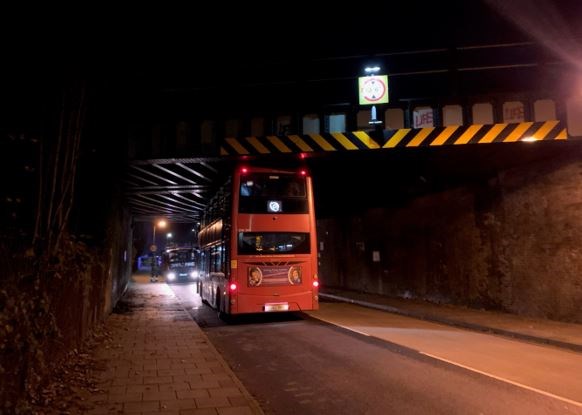Tuesday 22 Dec 2020
Renewed appeals to drivers of tall vehicles to take care after December spike in Kent and South East London bridge bashes
- Region & Route:
- Southern: Kent
- | Southern
The first half of December has seen bridge strikes in Kent and South East London occurring at nearly double the average rate, leading to renewed calls for drivers to know the heights of their vehicles.
Railway bridges in the county were hit at least 11 times over the first half of December, with incidents recorded at Chestfield, Headcorn, Herne Hill, Kent House, Rochester, Swalecliffe, Orpington, Petts Wood, Sole Street and West Malling.
December has seen almost double the average monthly number of bridge strikes in the county occurring and the rise in incidents reflects the highest number of strikes in the last 5 years.
The incident at Herne Hill cost nearly a thousand delay minutes to passengers, and the Orpington incident costing 303. The sudden rise is a cause for concern among those managing the Kent Route on behalf of passengers and freight.
Bridge strikes are costly to the network, not just in financial terms, but the costs in delays to passengers and freight.
Nationally, almost six out of ten (59%) of the incidents are caused by HGV drivers, and Network Rail is reminding drivers they can face tough penalties including removing a person’s public service vehicle (PSV) licence.
Automatic camera alert systems have been installed on 6 bridges in Kent to monitor them for movement, as with some bridge strikes not reported, it is imperative to make sure the bridges remain safe.
Daniel Matthews, Head of Operations for Kent, said: “The early part of December has seen a concerning increase in the rate of bridge strikes on our network.
"There is no excuse to not know the height of your vehicle before starting your journey.
“As well as putting lives in danger on both road and rail and causing lengthy delays for passengers and road users, drivers who chance it at bridges are at risk of leaving their employers with a hefty bill for repairs and train delay costs, along with a strong threat to their own operator licence.”
Scott Brightwell, Train Services Director for Southeastern, said:
“Bridge strikes cost train passengers and road users alike far too much time and money, and we can’t be clearer about our message to drivers of lorries and buses: check the height of your vehicle! Not only will oversized vehicles be extensively damaged, but they can cause huge disruption and embarrassment to say the least.”
To try and combat the number of bridge strikes, adverts are being placed at motorway service station petrol pumps across the country reminding drivers to “Wise Up, Size Up” as “Lorries Can’t Limbo” and drivers should know their vehicle height before they start their journey and to check their route for low bridges.
Notes to Editors
- More information on the 'Wise Up, Size Up' campaign can be found here
- Kent's railways saw a 5% reduction in bridge strikes last year but still experienced 131 of them leading to delays for passengers, inconvenience for motorists, and in some cases injuries.
- Kent route experienced 15,718 delay minutes (nearly 11 days) because of bridge strikes but those delays were a reduction of nearly half on the previous year.
- The most costly incident in Kent last year involved a bridge strike at Elmstead Woods in South London costing approximately £200,000 in delays and repairs.
Contact information
Passengers / community members
Network Rail national helpline
03457 11 41 41
Latest travel advice
Please visit National Rail Enquiries
Journalists
Scott Wilson
Media Manager
Network Rail
07395 389658
scott.wilson@networkrail.co.uk
About Network Rail
We own, operate and develop Britain's railway infrastructure; that's 20,000 miles of track, 30,000 bridges, tunnels and viaducts and the thousands of signals, level crossings and stations. We run 20 of the UK's largest stations while all the others, over 2,500, are run by the country's train operating companies.
Usually, there are almost five million journeys made in the UK and over 600 freight trains run on the network. People depend on Britain's railway for their daily commute, to visit friends and loved ones and to get them home safe every day. Our role is to deliver a safe and reliable railway, so we carefully manage and deliver thousands of projects every year that form part of the multi-billion pound Railway Upgrade Plan, to grow and expand the nation's railway network to respond to the tremendous growth and demand the railway has experienced - a doubling of passenger journeys over the past 20 years.
Follow us on Twitter: @networkrail
Visit our online newsroom: www.networkrailmediacentre.co.uk

